A polariscope is a useful tool in stress analysis because it allows for the visualization of stress patterns in transparent materials. When a material is subjected to external forces, such as pressure or tension, it can cause internal stresses within the material. These stresses can cause changes in the way that light passes through the material, which can be visualized using a polariscope.
By analyzing the patterns of light transmitted through the polariscope, it is possible to determine the magnitude and direction of the internal stresses within the material. This information can be used to assess the quality and reliability of the material, to detect potential defects or weaknesses, and to optimize manufacturing processes to reduce stress and improve performance.
In addition, polariscopes can be used to determine the mechanical properties of materials, such as their modulus of elasticity, which is a measure of their ability to withstand deformation under stress. This information is important in many fields, including materials science, engineering, and geology, where it is necessary to understand the behavior of materials under different types and levels of stress.
A polariscope strain viewer
A polariscope strain viewer is a type of polariscope that is specifically designed to visualize strain patterns in materials. It is used to analyze the behavior of materials under stress and to identify areas of stress concentration or deformation.
A polariscope strain viewer consists of two polarizing filters, as in a standard polariscope, but with the addition of a transparent layer that can be placed on the surface of the material being studied. This layer is typically made of a material that has a known strain-optic coefficient, such as mica, and it is used to create a strain field on the surface of the material.
When the material is placed between the polarizing filters and the strain viewer layer is applied, the material’s internal stresses cause the light passing through it to become polarized in different directions. As a result, the patterns of light transmitted through the polariscope can be analyzed to determine the magnitude and direction of the surface strains in the material.
Polariscope strain viewers are commonly used in the field of materials science and engineering to analyze the behavior of materials under different types and levels of stress, including tension, compression, bending, and torsion. They are also used in the study of geological materials, such as rocks and minerals, to determine the deformation and strain patterns that occur under natural forces, such as tectonic activity.
Technical specification of polariscope
A polariscope is an optical instrument that is used to measure and visualize stress in materials. Here are some technical specifications of a typical polariscope:
- Light source: A polariscope typically uses a monochromatic light source such as a sodium or mercury vapor lamp, or a laser.
- Polarizer: A polarizer is placed in front of the light source to produce a beam of polarized light.
- Sample holder: The sample holder is a platform on which the sample is placed. It may be adjustable to allow for different sample sizes and orientations.
- Analyzer: The analyzer is placed in front of the sample and is oriented at a 90-degree angle to the polarizer. It allows for the detection of changes in the polarization of light that have occurred as a result of the sample’s stress.
- Retarder: Some polariscopes have a retarder, which is a device that introduces a known amount of delay between the two beams of polarized light that pass through it. The retarder can be used to calculate the magnitude of the stress in the sample.
- Magnifier: A magnifier may be included in the polariscope to allow for detailed examination of the sample.
- Power source: A power source is required to operate the light source and any other electronic components of the polariscope.
These are the basic technical specifications of a polariscope, but there may be variations depending on the specific model or application.
The polariscope price can vary depending on its features, specifications, and the manufacturer. A basic polariscope without a retarder or magnifier can cost anywhere from a few hundred to a few thousand dollars. Polariscope models with additional features such as a retarder and magnifier can cost upwards of several thousand dollars.
High-end polariscopes with advanced features and capabilities can cost even more, sometimes in the tens of thousands of dollars. The price may also depend on the intended use of the polariscope, as some models are designed for specific industries or research applications, and may be more expensive due to their specialized features.
It is always a good idea to research different manufacturers and models to compare prices and features before making a purchase.
Read More about our others bottle testing instruments
top load tester, bottle neck cutter, color matching cabinet, hot wire bottle cutter, vibration table manufacturers.





